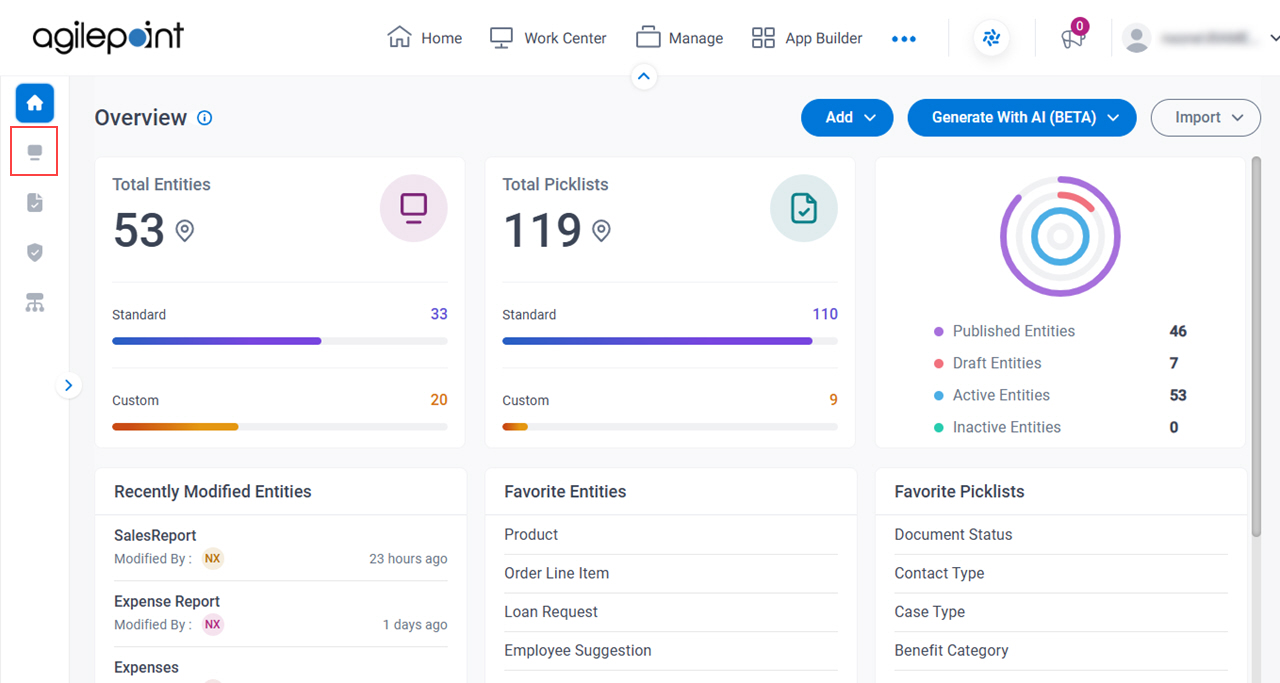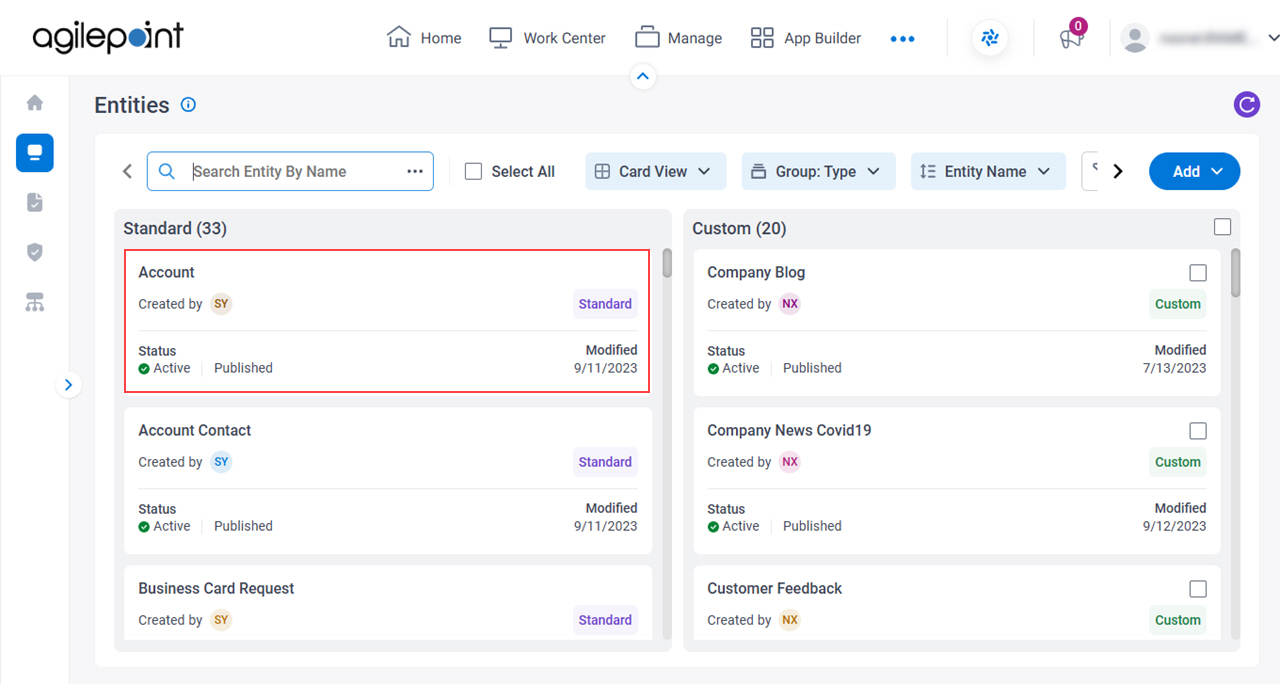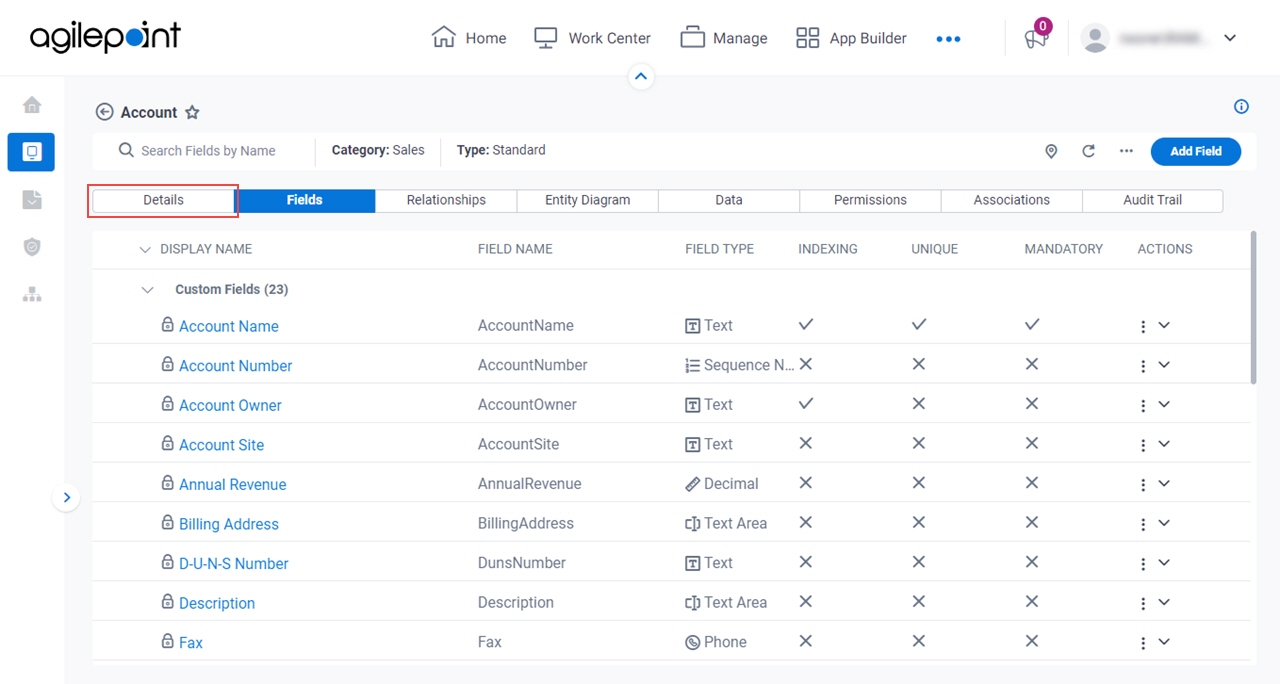Navigate To Other Entity 
|
- Opens this Screen:
- Navigate To Entity screen.
- Function of this Screen:
- Shows the list of AgilePoint NX entities. You can click the entity names to see or configure the entity.
|
Refresh 
|
- Function:
- Updates the information on the screen.
|
Clone Entity 
|
- Opens this Screen:
- Clone Entity screen.
- To Open this Field:
-
- On the right side of the screen, click the Ellipses (...).
- Function of this Screen:
- Creates a copy of an
entity..
- Example:
- Refer to:
|
Export Entity Model
|
- Opens this Screen:
- Export Entity Model screen.
- To Open this Field:
-
- On the right side of the screen, click
Ellipses (...).
- Function of this Screen:
- Downloads an entity template from AgilePoint NX
Data Entities to your local machine
as an XML file,
a JSON file, or
a Microsoft Excel file.
- Example:
- Refer to:
|
Export Data
|
- Opens this Screen:
- Export Data screen.
- To Open this Field:
-
- On the right side of the screen, click
Ellipses (...).
- Function of this Screen:
- Downloads records from an entity as an XML file, a JSON file, or a Microsoft Excel file to your local machine.
- Example:
- Refer to:
|
Import Data
|
- Opens this Screen:
- Import Data screen.
- To Open this Field:
-
- On the right side of the screen, click
Ellipses (...).
- Function of this Screen:
- Uploads a collection of exported records from your local machine, and adds it to an entity in AgilePoint NX Data Entities.
- Example:
- Refer to:
|
Import Fields
|
- Opens this Screen:
- Import Fields screen.
- To Open this Field:
-
- On the right side of the screen, click
Ellipses (...).
- Function of this Screen:
- Uploads a group of exported entity fields from your local machine, and adds it to an entity in AgilePoint NX Data Entities.
- Limitations:
-
This field
is available in these releases:
|
|
Sync Analytics
|
- Function:
- Creates a connection between an entity with the Analytics database where the entity data is updated for reporting and analytics.
- To Open this Field:
-
- On the right side of the screen, click
Ellipses (...).
|
Delete Entity  |
- Opens this Screen:
- Type CONFIRM To... screen
- Function of this Screen:
- Deletes your custom entity.
To delete an entity, set Custom Entities Can Be Deleted to Yes on the
Data Entities screen (Settings).
You can not delete a standard entity.
- Limitations:
-
When a user deletes an entity, both the design time
and runtime data
associated with the entity are permanently deleted in AgilePoint NX. Before you delete an entity,
AgilePoint recommends you back up the entity in the workflow database.
To back up the data, contact your database administrator.
- Example:
- Refer to:
|
|
Edit 
|
- Function:
- Changes the information for a
custom entity.
- Example:
- Refer to:
|
ID |
- Description:
- Shows the ID of an entity.
This ID is created by default.
- Allowed Values:
- Read only.
|
Display Name |
- Description:
- Specifies the name that shows for the
custom entity in AgilePoint NX.
- Allowed Values:
- One line of text (a string).
Accepted:
- Default Value:
- None
- Example:
- Refer to:
|
Plural Name |
- Description:
- Specifies the name that shows for the
custom entity
when there is more than one. In other words, this is the plural version of the entity name.
- Allowed Values:
- One line of text (a string).
Accepted:
- Default Value:
- None
- Example:
- If entity name is Country,
you may want to use the plural name Countries.
Also refer to:
|
Internal Name |
- Description:
- Shows a unique name for the
entity.
- Allowed Values:
- Read only.
- Example:
- Refer to:
|
Description |
- Description:
- Specifies an optional text description for your custom entity.
- Allowed Values:
- More than one line of text.
- Default Value:
- None
- Example:
- Refer to:
|
Category |
- Description:
- Specifies a category for your
custom entity.
- Allowed Values:
- A category from the list.
- Default Value:
- None
- Example:
- Refer to:
|
Owner |
- Description:
- Specifies the name of the user to be an owner of your
custom entity.
- Allowed Values:
- A user name from the list.
- Default Value:
- None
- Limitations:
-
This field
is available in these releases:
|
Owner Full Name |
- Description:
- Shows the full name of the user who is the owner of your
custom entity.
- Allowed Values:
- Read only.
- Default Value:
- The full name of the user specified in the Owner field.
|
Publish Status |
- Description:
- Specifies whether an entity is ready to use.
- Allowed Values:
-
- On - An entity is ready to use.
- Off - An entity is in draft.
- Default Value:
- Off
- Example:
- Refer to:
|
Record Limit |
- Description:
- Specifies the maximum number of
records to get from an
entity.
- Allowed Values:
- An integer.
Range:
- Default Value:
- 1000000
- Example:
- Refer to:
|
Active |
- Description:
- Specifies whether an entity
can be used by an app.
- Allowed Values:
-
- On - The entity can be used in apps.
- Off - The entity can be viewed or changed in
Data Entities, but it does not
show in the App Builder.
- Default Value:
- On
- Example:
- Refer to:
|
Use The Default Event Logging For AgilePoint NX Apps / Create Detailed Audit Logs For This Entity |
- Description:
- Specifies the audit level to track and store events that occur for the
custom entity.
- Allowed Values:
-
- On - Tracks and stores all events that occur on the entity.
- Off - Does not store events for the entity except normal error logging for your app.
- Default Value:
- Off
- Example:
- Refer to:
|
Allow Entity Model Import |
- Description:
- Lets which users can import entity model to AgilePoint NX
Data Entities.
- Allowed Values:
-
- Default Value:
- On
- Example:
- Refer to:
- Limitations:
- By default, this field is enabled in these releases:
|
Allow Entity Model Export |
- Description:
- Specifies which users can export an entity model.
- Allowed Values:
-
- On - All users who have access can export the entity model.
- Off - Only Administrator
and Entity Owners can export
the entity model.
- Default Value:
- On
- Example:
- Refer to:
- Limitations:
- By default, this field is enabled in these releases:
|
Allow Record Export |
- Description:
- Specifies which users can export the
records
from an entity.
- Allowed Values:
-
- Default Value:
- On
- Example:
- Refer to:
- Limitations:
- By default, this field is enabled in these releases:
|
Allow Record Import |
- Description:
- Specifies which users can import
records to
an entity.
- Allowed Values:
-
- Default Value:
- On
- Example:
- Refer to:
- Limitations:
- By default, this field is enabled in these releases:
|
Enable Analytics |
- Description:
- Specifies whether an entity
can be viewed or used for reports in
Analytics Center.
- Allowed Values:
-
- On - The entity can be viewed or used for reports in Analytics Center.
- Off - The entity cannot be viewed or used for reports in Analytics Center.
- Default Value:
- On
- Limitations:
-
This field
is available in these releases:
|
Enable Data Tracking |
- Description:
- Specifies whether to enable the Data Tracking feature for the entity to track the changes made to the data in the records.
- Allowed Values:
-
- Default Value:
- Off
- Limitations:
-
This field
is available in these releases:
|
Update |
- Description:
- Saves the values and configuration you entered for the
entity.
- To Open this Field:
-
- On the
Details tab, click Edit
 . .
|
Reset |
- Description:
- Deletes the values you entered for the
entity.
- To Open this Field:
-
- On the
Details tab, click Edit
 . .
|
Back  |
- Description:
- Goes to the previous screen.
- To Open this Field:
-
- On the
Details tab, click Edit
 . .
|
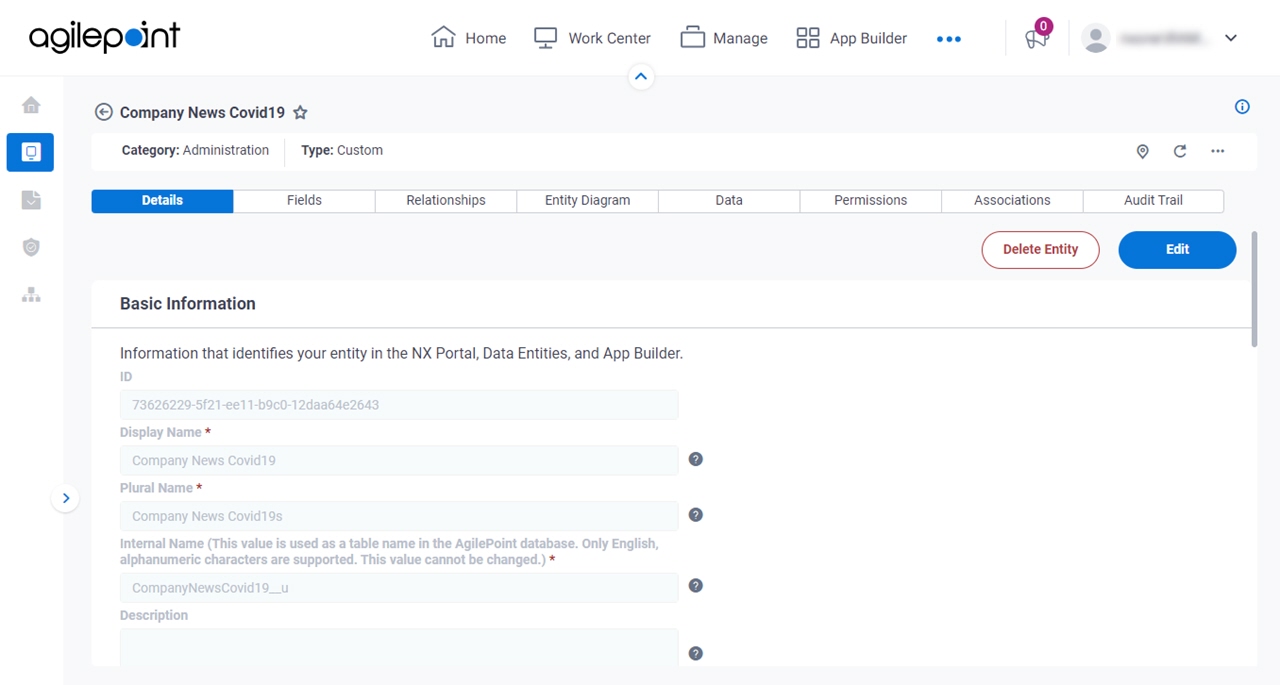
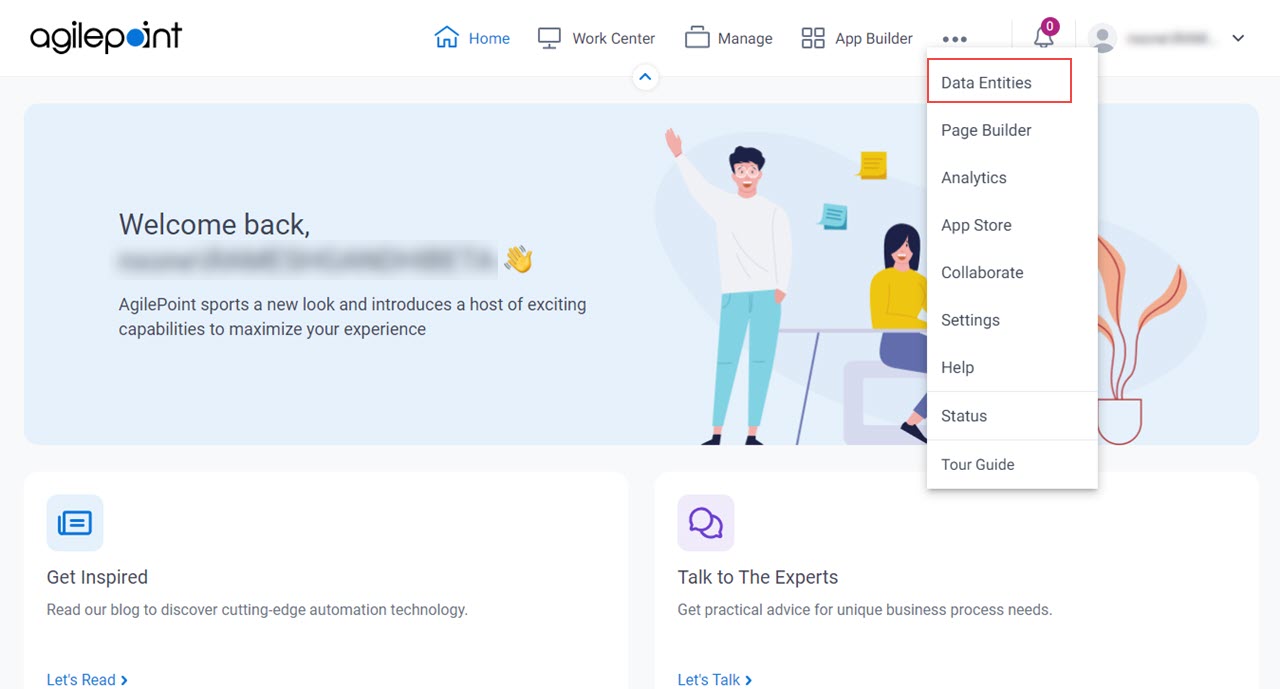
 .
.
